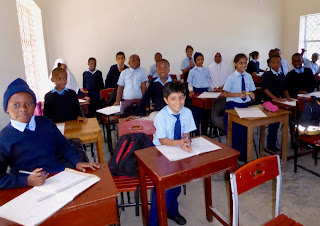This morning, Ray came to pick up John for a visit to Anita’s school. I had visited it last year and was extremely impressed with both the physical facilities and the staff. It is by far the best private school—outside of the international schools circuit—that I personally have seen in Africa. This Prime School is fairly new and is still developing and building its campus. They have students from pre-school through grade 7. Soon they hope to add several more years so as to cover the O level (grades K thru 7 ) as well. They also have plans to build a swimming pool so that all their students can enjoy swimming without paying extra fees to swim at another facility.
John’s visit followed the usual format: first a call at the director’s office, where he met the director and his assistant, and then a tour of classrooms. Like me, John was very impressed with the facilities and the quality of the teachers, who come from a variety of ethnic backgrounds and religions. Classes are limited to 30 and then divided into half for teaching core subjects. John also got to see the completed computer classroom, which was being built when I visited last year. The director said that use of the computers will begin in grade 1.
 |
| John with the director and assistant director |
 |
| The 1st grade classroom. |
 |
| The interior courtyard for the higher grades, designed so that every classroom has plenty of natural light. |
 |
| Anita's class. She is second from the left. |
Our friend Sharon Mkisi had invited us to join her and another friend, Terry Morton, at a reading by a Tanzanian author this evening. This event was being held at the African Cultural Heritage Center, which is a huge gaudy campus showcasing all sorts of art and tourist amusements. Except for the art gallery, I usually try to avoid this place, but being with Sharon and Terry was too tempting to turn down. We all met at 5:00 p.m. at Sharon’s office at the Anglican cathedral, and she drove us out to the center.
Gallery Staff had set up a bar on the terrace of the art gallery, and soon there were also freshly made samosas for sale, either vegetable or mutton. John was in samosa heaven! The reading was to begin at 6:00, so we all wandered into the auditorium and few minutes before the hour, and then waited for over an hour for the program to begin. Apparently certain important people were caught in traffic and things couldn’t begin until they arrived. Since many of us in the audience knew each other from other places, we had plenty of time to catch up with one another.
Finally, sometime after 7:00, the author, Maria Nhambu, came in and soon began her presentation. I hadn’t known anything about her except that she had been a Tanzanian orphan who had been adopted at the age of 19 and taken to the States. She did not read, but rather, spoke for an hour and a half about her life, first as a very mistreated child without any known identity who had been dropped at a Catholic orphanage for biracial children when she was 3-days-old. Then, at age 19, she was adopted by a 23-year-old American volunteer teacher, Catherine Murray, (Yes, her mother is barely 4 years older than she is) and left Tanzania to begin another life in America. In a series of incredible events, Maria finally met her birth mother, found a half-brother in Boston, and eventually came back to Tanzania with her brother to search for her father. That brought the discovery of another completely new family. The drama of her life is now all recorded in a trilogy, which can be found and purchased on Amazon. I bought the first volume, Africa’s Child, last night so that I could have it signed. Then, I bought the following two volumes, America’s Daughter and Drum Beats, Heart Beats on Kindle, which is much cheaper. (Go to www.marianhumba.com to learn more)
 |
| Getting the book Africa's Child signed by Maria Nhambu |
It was unexpected when Maria introduced her adoptive mother, who was sitting in the audience looking just like many of the old timers who stay in Tanzania instead of returning to their countries of origin. The legendary Simonson family was represented by their matriarch, Eunie, and her two daughter’s, Rebecca and Naomi. They appear in this trilogy someplace and were apparently the people whose late arrival held up the program. I was interested in seeing who linked with whom and how variegated the racial connections were. The entire evening was a wonderful experience in cross-cultural mixing and celebration.
 |
| L to R: Cathy, Nhambu's mother, Eunice Simonson, Sharon Mkisi |
No comments:
Post a Comment